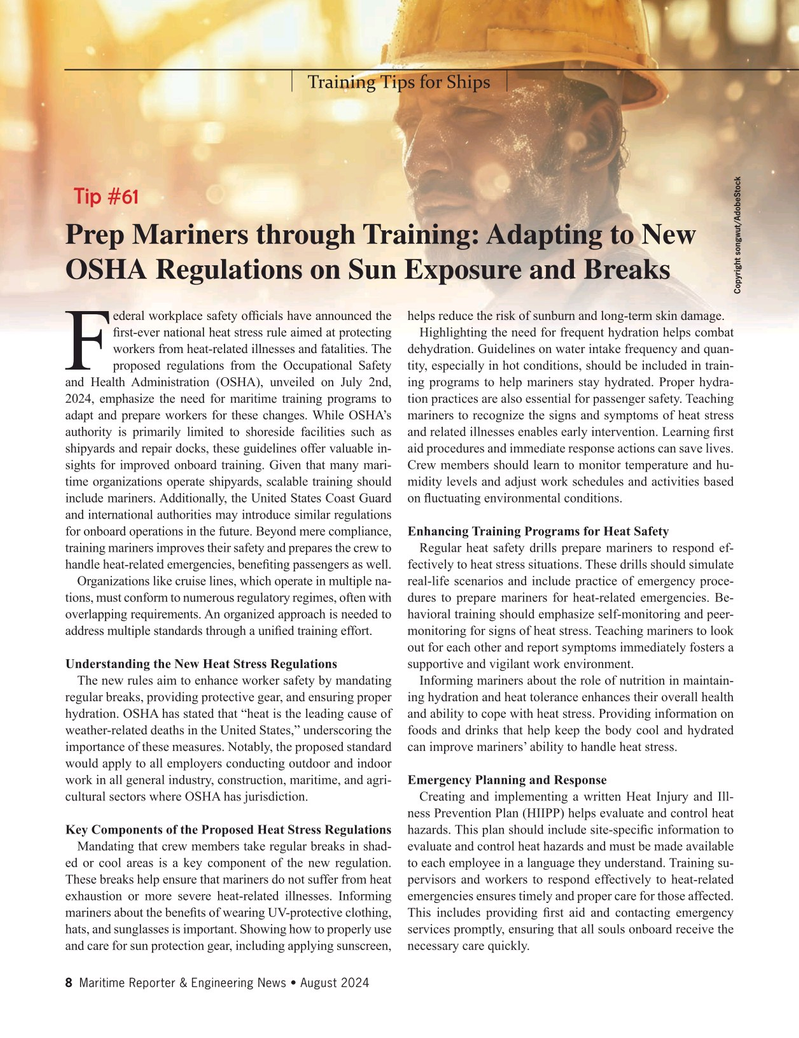
Page 8: of Maritime Reporter Magazine (August 2024)
Read this page in Pdf, Flash or Html5 edition of August 2024 Maritime Reporter Magazine
Training Tips for Ships
Tip #61
Prep Mariners through Training: Adapting to New
OSHA Regulations on Sun Exposure and Breaks
Copyright songwut/AdobeStock ederal workplace safety of? cials have announced the helps reduce the risk of sunburn and long-term skin damage.
? rst-ever national heat stress rule aimed at protecting Highlighting the need for frequent hydration helps combat workers from heat-related illnesses and fatalities. The dehydration. Guidelines on water intake frequency and quan-
Fproposed regulations from the Occupational Safety tity, especially in hot conditions, should be included in train- and Health Administration (OSHA), unveiled on July 2nd, ing programs to help mariners stay hydrated. Proper hydra- 2024, emphasize the need for maritime training programs to tion practices are also essential for passenger safety. Teaching adapt and prepare workers for these changes. While OSHA’s mariners to recognize the signs and symptoms of heat stress authority is primarily limited to shoreside facilities such as and related illnesses enables early intervention. Learning ? rst shipyards and repair docks, these guidelines offer valuable in- aid procedures and immediate response actions can save lives. sights for improved onboard training. Given that many mari- Crew members should learn to monitor temperature and hu- time organizations operate shipyards, scalable training should midity levels and adjust work schedules and activities based include mariners. Additionally, the United States Coast Guard on ? uctuating environmental conditions.
and international authorities may introduce similar regulations for onboard operations in the future. Beyond mere compliance, Enhancing Training Programs for Heat Safety training mariners improves their safety and prepares the crew to Regular heat safety drills prepare mariners to respond ef- handle heat-related emergencies, bene? ting passengers as well. fectively to heat stress situations. These drills should simulate
Organizations like cruise lines, which operate in multiple na- real-life scenarios and include practice of emergency proce- tions, must conform to numerous regulatory regimes, often with dures to prepare mariners for heat-related emergencies. Be- overlapping requirements. An organized approach is needed to havioral training should emphasize self-monitoring and peer- address multiple standards through a uni? ed training effort. monitoring for signs of heat stress. Teaching mariners to look out for each other and report symptoms immediately fosters a
Understanding the New Heat Stress Regulations supportive and vigilant work environment.
The new rules aim to enhance worker safety by mandating Informing mariners about the role of nutrition in maintain- regular breaks, providing protective gear, and ensuring proper ing hydration and heat tolerance enhances their overall health hydration. OSHA has stated that “heat is the leading cause of and ability to cope with heat stress. Providing information on weather-related deaths in the United States,” underscoring the foods and drinks that help keep the body cool and hydrated importance of these measures. Notably, the proposed standard can improve mariners’ ability to handle heat stress.
would apply to all employers conducting outdoor and indoor work in all general industry, construction, maritime, and agri- Emergency Planning and Response cultural sectors where OSHA has jurisdiction. Creating and implementing a written Heat Injury and Ill- ness Prevention Plan (HIIPP) helps evaluate and control heat
Key Components of the Proposed Heat Stress Regulations hazards. This plan should include site-speci? c information to
Mandating that crew members take regular breaks in shad- evaluate and control heat hazards and must be made available ed or cool areas is a key component of the new regulation. to each employee in a language they understand. Training su-
These breaks help ensure that mariners do not suffer from heat pervisors and workers to respond effectively to heat-related exhaustion or more severe heat-related illnesses. Informing emergencies ensures timely and proper care for those affected. mariners about the bene? ts of wearing UV-protective clothing, This includes providing ? rst aid and contacting emergency hats, and sunglasses is important. Showing how to properly use services promptly, ensuring that all souls onboard receive the and care for sun protection gear, including applying sunscreen, necessary care quickly.
8 Maritime Reporter & Engineering News • August 2024
MR #8 (1-17).indd 8 8/8/2024 10:08:54 AM

 7
7

 9
9
